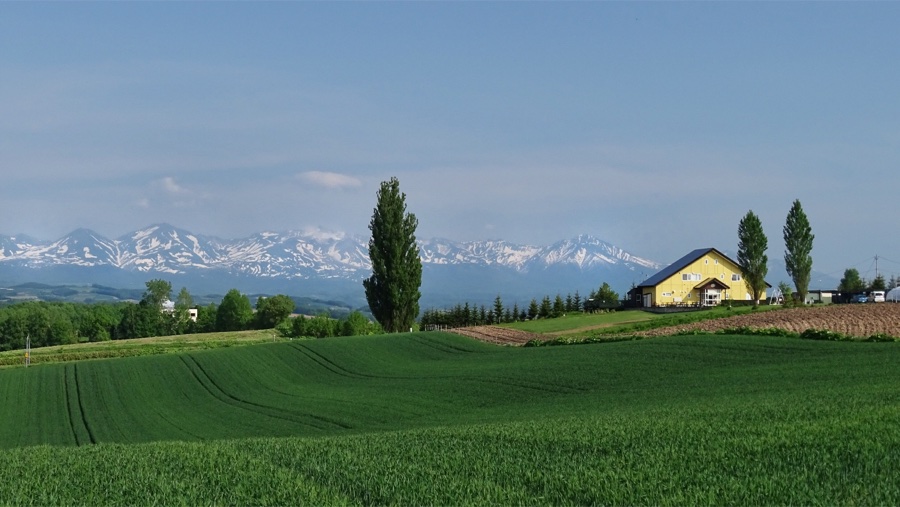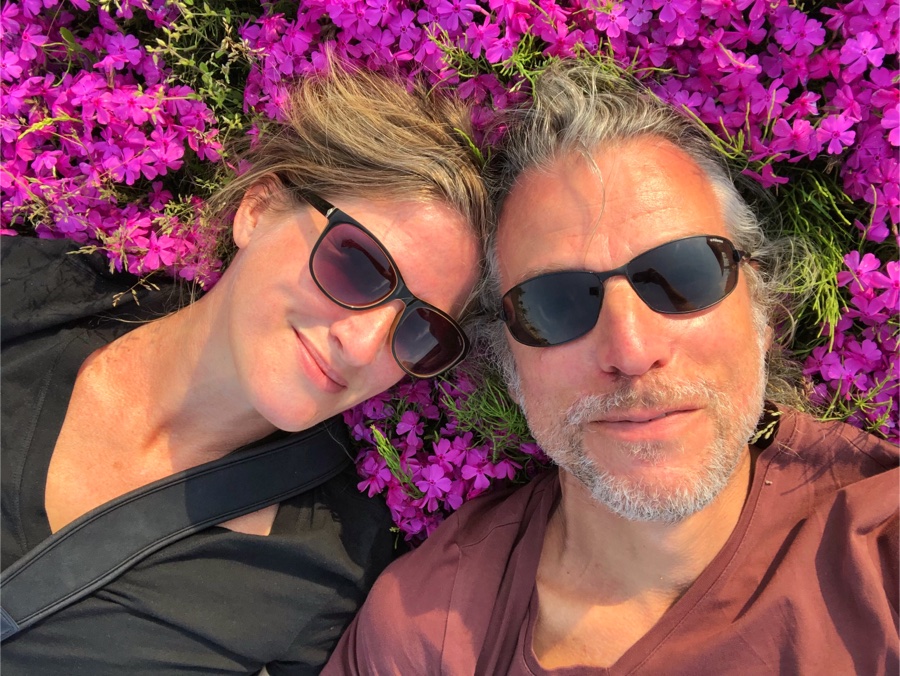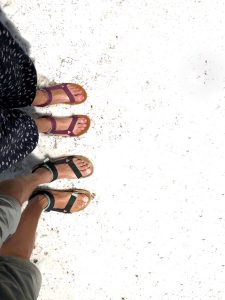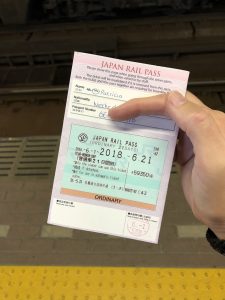Japan
May - June 2018
 Japan, it’s so easy that it’s almost complicated… you don’t have to think about anything, everything is comfortable and made to suit your needs. Japan is interesting, unknown, exciting, safe, and above all stunning… and we were there for four weeks!
Japan, it’s so easy that it’s almost complicated… you don’t have to think about anything, everything is comfortable and made to suit your needs. Japan is interesting, unknown, exciting, safe, and above all stunning… and we were there for four weeks!
This collective of islands with over a 127 million inhabitants has a long and complicated history when it comes to tradition. From this tradition roles, values and beliefs are incredibly important but can be quite complicated for outsiders. It can take years to really understand what it’s all about, for these characteristics are deeply rooted within the core of their soul.
 As a country Japan has been closed off for outsiders for many many centuries, that probably causes a big part of the distance between us.
As a country Japan has been closed off for outsiders for many many centuries, that probably causes a big part of the distance between us.
To make things easier there aren’t many Japanese people who speak English. We’ve used Google translate a lot, actually we could not live without it. But with hands and feet pantomime we came a long way too.
Asking something in the street or at the train station we’ve had most luck with businessmen. If you want to make a good impression, try learning some Japanese phrases like these:
- Konnichiwa : hello, good morning
- Sumimasen: excuse me
- Hai: yes
- Ie (pronounce as iejè): no
- Arigatou: thank you!
- Dôzo: please
- Itadakimasu: enjoy your meal
- Ichi: one
- Ni: two
- Biru: beer (this one is very important of course)
We’ve been in Japan for four weeks and still haven’t been able to figure out just a tiny bit of what this culture is about.
The one thing that we did experience is that people obey to the rules, always. This can be incredibly annoying if you jussst need them to bend with you for a bit, but on the other hand it’s very predictable and you know exactly where you stand. So, our credo: if you can’t beat them, join them 😉
We start our adventures in Sapporo, the capital city of the Northernmost island of Japan Hokkaido. Probably the least touristic one too. Not easy to get acquainted with a country where nobody speaks English. Lucky for us we understood the language of nature and enjoyed the scenery to the fullest. This resulted into a lot of ohh’s and ahh’s in our first 10 days in this weird country.
By super duper bullettrain we continue our journey through Japan on the biggest island Honshu. Big modern cities and traditional shrines… In 2.5 weeks we just didn’t have enough time to see everything on our list because it kept growing and growing. The beauty and authenticity this island has to offer is beyond compare.
As if this wasn’t enough we also were quite close to an earthquake too…
Gimme more!
 Japanese behavior is not always understandable, not always the best way, but predictable… most of the time.
Japanese behavior is not always understandable, not always the best way, but predictable… most of the time.
On the streets you will not find a trash bin. It is your trash, so you take it home and dispose of it yourself. So logical!
Waiting for something? You just wait in line, that is obvious and fair, right?
Anything to make things easier for you. A bathtub with stripes that measure how much water you’ll need per ten kilos of body weight. An umbrella blow dryer at the entrance of a store. Button panels on four sides inside the elevator, because what if you can’t reach it?! Diagonal zebra crossings and although we haven’t seen a blind person anywhere the beeps, braille and blind guiding systems in every street where ever you go.
Furthermore, I don’t want to complain, but Japanese like it hot! I don’t mean the porn way (that too) but the heating… it’s set at 25 degrees wherever you go and still people are wrapped in thick coats and scarves.
Hot hotels, shops, in the train, restaurants, everywhere. Warm blankets on the bed that would be too much in Siberia and even the toilet seats are uncomfortably warm.
 Toilets in Japan are really weird by the way. Most of then have a lot of undefinable buttons, sometimes you won’t even know how to flush.
Toilets in Japan are really weird by the way. Most of then have a lot of undefinable buttons, sometimes you won’t even know how to flush.Some toilets have a flushing sound when you sit down, because God forbid someone would hear you pee!
There is an adjustable spraywash for all sides of the bottom. The rest of the buttons… we still don’t know.
The Japanese are not only very traditional but also quite rigid and prudish, not only in their toilet-use 😉
Men wear a white shirt with tie and black or grey business-suit and women fortunately have a bit more imagination but like their shoulders well covered and over knee skirts.
Dressing in ‘short’-shorts and spaghetti top is considered inappropriate, so don’t.
So apart from being conservative, they obviously love to have things clean and hygienic too, which we totally dig. But we cannot get over the plastic thing, plastic plastic plastic… it is truly sad. They use plastic for everything. King of the plastic… Disposable cups, cutlery and bathroom accessories: plastic. In the supermarket ABSOLUTELY EVERYTHING is wrapped in plastic ánd has a nice thick firm plastic box around it too. When you pay you’ll get a big plastic bag for your collection. We try our best not to buy too much that is wrapped in plastic and always have a used bag with us, but totally banning plastic is virtually impossible in this country.
Although safety is a big deal in this country, it is obvious there is no education from the government about anything regarding health or environment. Smoking, unhealthy food, plastic, spending money… in this optic Japan unfortunately is just like any other Asian country.
 Accommodation can be expensive in Japan. Some people think they need to book a year ahead but we’ve noticed that hotels really aren’t full and most have special deals through booking sites at the last minute. This can make the difference between the usual offer of ¥8000 (€62) and a last minute deal of ¥4500 (€35). We’ve slept mostly in hotels with a small double bed, a bathroom and all of them had a refrigerator. The room is quite small but just enough for two and the bathroom is tiny but useful. The bed… well, you get used to it.
Accommodation can be expensive in Japan. Some people think they need to book a year ahead but we’ve noticed that hotels really aren’t full and most have special deals through booking sites at the last minute. This can make the difference between the usual offer of ¥8000 (€62) and a last minute deal of ¥4500 (€35). We’ve slept mostly in hotels with a small double bed, a bathroom and all of them had a refrigerator. The room is quite small but just enough for two and the bathroom is tiny but useful. The bed… well, you get used to it.
The beds are generally quite comfy, so this makes up for the lack of space. Do be careful not to book a smokers room for most hotels offer them in galore.
We’ve paid an average of €38 (¥4900) per night but had some great last minute deals. In several hotels of this level we’ve paid around €32 (¥4100). Saturdays is usually a busy and more expensive day, prices go up with a 100% and it can be a bit harder to find something in your preferred area.
Checking in time means you cannot check in earlier. Most hotels don’t understand that if you do the administrative stuff immediately you’ll just have to give your guests the room key. Now you have to come back after an hour or so, and wait in line, because everybody is checking in at the same time. Quite annoying but you get used to it. We arrived at a hotel and the receptionist told us, sorry check in is at three. We looked at the clock, it was ten to three. Alllllriggghhhht… sigh…
We’ve left our bags at the hotel for the day of arrival, no problems with that, they handle with much care.
Airbnb
Although we did not use Airbnb, it is changing since recently. Sadly the government has decided that from half June 2018 all hosts will need a permit to rent out a room or apartment otherwise they will be shut down. We can sense a disaster coming…
 Japan has millions of restaurants, tiny narrow Ramen, Sushi and Teppan-Yaki shops. Most of them are hidden on one of the floors in the high buildings spread through the city. Dining in a restaurant can be quite expensive, for most meals you’ll have to pay between ¥1800 (€14) and ¥2500 (€20) per person off your budget. Ramen, a Japanese noodle soup, is much cheaper but didn’t do it for us as a full meal.
Japan has millions of restaurants, tiny narrow Ramen, Sushi and Teppan-Yaki shops. Most of them are hidden on one of the floors in the high buildings spread through the city. Dining in a restaurant can be quite expensive, for most meals you’ll have to pay between ¥1800 (€14) and ¥2500 (€20) per person off your budget. Ramen, a Japanese noodle soup, is much cheaper but didn’t do it for us as a full meal.
Luckily there is another option to fill your tummy: Okonomiyaki.
 What?! Okonomiyaki is a pancake with cabbage, noodles, bacon, egg, spices and sauce transformed on a hot plate into a very tasty caloriebomb-pie. The price is about ¥850 (€6.60) for a basic Okonomiyaki including the show and a real Japanese experience 🙂
What?! Okonomiyaki is a pancake with cabbage, noodles, bacon, egg, spices and sauce transformed on a hot plate into a very tasty caloriebomb-pie. The price is about ¥850 (€6.60) for a basic Okonomiyaki including the show and a real Japanese experience 🙂
Supermarkets offer hundreds of tiny meals which cost somewhere between ¥100 (€0.80) and ¥400 (€3.10), it’s like going out for tapas. Yummy goodies as well as weird yucky stuff. Unfortunately all of them separately wrapped in a plastic box.
With about €3-4 (¥400-500) per person we could gather a new tasty dinner every day. And when you shop after 6 pm you’ll probably get a lot of discount too! The quality depends strongly on the supermarket but mostly it’s very tasty. The only thing is, I just can’t get over the plastic packages.
We’ve found there is quite a wide variety of vegetarian food in the larger supermarkets. Self service salad bars with great steamed veggies.
 Although the food range is wide, eating healthy on a budget can be a challenge. Fruit is incredibly expensive, pay ¥250 (€2) for an apple or ¥800 (€6.25) for a mango. Most raw eatable vegetables are double or triple the price we are used to in Europe. A tomato for ¥250 (€2), thin (but very tasty) cucumber for ¥200 (€1.60). We’ve found some great deals walking around, like an enormous juicy apple for ¥100 (€0.80) or a box of cherry tomatoes for ¥150 (€1.30). So shopping around does pay off! The one thing you can’t avoid is the high price for dairy. A liter milk or a few slices of cheese are crazy expensive not to mention the unreadable packaging. We’ve found a great page online that explains the milk labels in supermarkets, find it here.
Although the food range is wide, eating healthy on a budget can be a challenge. Fruit is incredibly expensive, pay ¥250 (€2) for an apple or ¥800 (€6.25) for a mango. Most raw eatable vegetables are double or triple the price we are used to in Europe. A tomato for ¥250 (€2), thin (but very tasty) cucumber for ¥200 (€1.60). We’ve found some great deals walking around, like an enormous juicy apple for ¥100 (€0.80) or a box of cherry tomatoes for ¥150 (€1.30). So shopping around does pay off! The one thing you can’t avoid is the high price for dairy. A liter milk or a few slices of cheese are crazy expensive not to mention the unreadable packaging. We’ve found a great page online that explains the milk labels in supermarkets, find it here.
We’ve bought the small drinking packs of milk (¥120 / €1.00 for 200 ml) with milk for our coffee and fake cheese not 100% dairy (¥380 / €3.00 for 7 slices) and still we paid enough. So, can you easily go without dairy or fruit, your daily budget can be brought down with at least €10.00 (¥1280) a day.
We are happy to say, the tapwater in Japan is of good quality, in most cities you can drink it without filtering. Good for the budget great news for the plastic-heap… you can refill your bottle as much as you want.
Food and clean water is not the only way to stay healthy of course, we found it not necessary to take malaria tablets. Are you planning to live on a farm or get deep into the forests you should ask Google, just to make sure.
The only thing that can easily make you sick is a parasite. Raw fish in sushi often contains worms. No need to worry, not all of them are a reason to panic but there are a few that can make your life miserable for a while. Stomach pains and nausea. We ate everything and never got sick from anything. But it ís wise to take some anti-parasite tablets after your trip, just to make sure you leave them where they belong when you go home 😉
 Japan has season just like other countries on this side of the equator, cool to freezing in the wintermonths October to April, nice and warm in the summer between May and September. Extreme heat is not common on Honshu and Hokkaido. Hokkaido has a cooler climate as it is further up north. Here temperatures usually don’t go below -4 centigrade but with heavy snowfall and extreme temperatures in the mountains.
Japan has season just like other countries on this side of the equator, cool to freezing in the wintermonths October to April, nice and warm in the summer between May and September. Extreme heat is not common on Honshu and Hokkaido. Hokkaido has a cooler climate as it is further up north. Here temperatures usually don’t go below -4 centigrade but with heavy snowfall and extreme temperatures in the mountains.
The country has a monsoon period in summer known as the ‘Tsuyu’ or ‘Baiyu’. From half June to end July it can rain a lot, every day, some days, some showers or a daylong downfall.
This monsoon only affects the islands below Hokkaido.
This doesn’t mean there is no rain up north though. Actually we’ve had more rainy days in Hokkaido than we did in Honshu!
You’d think this would not be the best period for a visit to this country but as said the rain hasn’t affected us at all. The temperatures were amazing, somewhere around 22 degrees in Hokkaido to 26 in Honshu.
What we did notice was that we were exactly in between Hokkaido’s flowering season, the cherry blossom had come to its end, tulips were harvested and the fields of lavender were still green. So if that’s what you are after, check the blooming periods online! The only flower we did find was the pink moss, it’s gorgeous and it was everywhere!
 Going to Japan it’s a good idea to plan ahead, for transportation can be expensive. We’ve thoroughly checked all the rates along our route, as far as we had one, and came to the conclusion we did need a Rail Pass. Eventhough at first we thought we wouldn’t buy one, we’d take the bus and travel as cheap as possible. But now that we’ve sort of put together our itinerary we see the difference between a train pass and separate tickets is so small it would be safer to have the pass. If we would make any changes to this itinerary we’d overspend.
Going to Japan it’s a good idea to plan ahead, for transportation can be expensive. We’ve thoroughly checked all the rates along our route, as far as we had one, and came to the conclusion we did need a Rail Pass. Eventhough at first we thought we wouldn’t buy one, we’d take the bus and travel as cheap as possible. But now that we’ve sort of put together our itinerary we see the difference between a train pass and separate tickets is so small it would be safer to have the pass. If we would make any changes to this itinerary we’d overspend.
We also considered buying a pass for one or two separate weeks to travel through the more expensive part of Japan, around Tokyo and buy a few separate tickets for the rest of our stay. But a week pass costs half of a three week pass and eventually this would not be cheaper… so, a JR Rail Pass!
The pass is valid for JR trains and buses and even a ferry all over Japan with an exception of a few small routes.
 The costs are ¥29.110 (€225), ¥46.390 (€360) or ¥59.350 (€460) per person for one, two or three weeks. These are the prices when buying the pass outside Japan. Until 2017 you could only purchase the pass outside Japan, since this year it is possible to buy the pass in Japan. Now the pass is also available in a limited number at some offices in Japan, the price will be slightly higher, add about ¥5.650 (€44) to each pass.
The costs are ¥29.110 (€225), ¥46.390 (€360) or ¥59.350 (€460) per person for one, two or three weeks. These are the prices when buying the pass outside Japan. Until 2017 you could only purchase the pass outside Japan, since this year it is possible to buy the pass in Japan. Now the pass is also available in a limited number at some offices in Japan, the price will be slightly higher, add about ¥5.650 (€44) to each pass.
Because we only decided to buy the pass two days before our arrival, we found a company that sends the vouchers for the JR Rail Passes to any hotel in Japan for only €10 (¥1280), you can find their website here.
Three days later the vouchers arrive from Paris by FedEx at our hotel reception. The vouchers needs to be activated within 30 days after purchase. At one of the offices that are stated on their website you switch the vouchers for a pass. Take your passport!
With the Rail Pass you can also make seat reservations on the Shinkansen but as long as you travel outside rush hour this is not necessary. Just go to the JR booking office in almost every station up to a few minutes before departure. Reserving a seat is also possible online for some routes up to three days in advance. You’ll need to pick up the ticket at least a day before departure so booking online is only useful if you’ll travel during rush hour.
An overview of our transportation costs:
We’ve actually spend ¥64,740 (€504) per person on trains…
If we wouldn’t have a Rail Pass this amount would have been ¥101,850 (€794) per person on exactly the same trains. But if we wouldn’t have had the Rail Passes we would have traveled with the cheaper options like buses, this would have been our costs: ¥66,180 (€515) per person.
So in our itinerary the Rail Pass didn’t safe us a lot of money but we traveled much more comfortable and a lot faster!
Renting a car
Another option for transport is to rent a car. The daily costs are about the same (excluding petrol and based on two persons) as a JR Train Pass but the freedom is unlimited. Besides, Japanese love camping, so the accommodation options are unlimited too. There are even camper-vans available!
Especially in a less crowded area like Hokkaido this would have been a great choice. You will need an International Drivers Licence which is valid for one year. Because ours expired a few months ago there was NO WAY to rent a car in Japan, for they stick to the rules like glue.
You can only get an International Drivers License by applying for it in your home country in person, so renting a car was out of the question for us.
 Japan is the country of awesome super-highspeed internet, WiFi can be found anywhere but not always free to connect to. Buying a simcard can be a good idea, but we decided to rent a pocket WiFi. This small device has a 4G simcard with unlimited data is quite popular with tourists for you can can be online whenever and wherever you want with multiple devices. The price is about ¥440 (€3.50) per day. The device was delivered to our hotel and after our rental period we put the Pocket WiFi and it’s charger in the envelope they’ve also send us and throw it in a mailbox.
Japan is the country of awesome super-highspeed internet, WiFi can be found anywhere but not always free to connect to. Buying a simcard can be a good idea, but we decided to rent a pocket WiFi. This small device has a 4G simcard with unlimited data is quite popular with tourists for you can can be online whenever and wherever you want with multiple devices. The price is about ¥440 (€3.50) per day. The device was delivered to our hotel and after our rental period we put the Pocket WiFi and it’s charger in the envelope they’ve also send us and throw it in a mailbox.
We have rented the Pocket WiFi with this company, which had great prices and reviews… but there are many others!
Internet in general is very open and free in Japan (unlike neighbouring country China), you can watch anything you like and download whatever you want, we’ve found only two things very annoying: all pages you look up are in Japanese, can be irritatingly difficult to find the change language button, and you can’t download a map on Google maps. But with that superfast internet you don’t need a downloaded map anyway 😉
 Currency: 100 Japanese Yen = € 0.80
Currency: 100 Japanese Yen = € 0.80
In these 27 days in Japan we’ve spend:
- Transportation: € 1029.70 (incl. Rail Pass *)
- Accommodation: € 1003.45
- Food and drinks: € 759.10
- Entrance fees: € 209.10
- Other: € 130.15 (a.o. pocket wifi)
That brings us to a daily budget of: € 115.98 for two persons including everything except international flights.
We’ve stayed in different hotels all over the country with or without airconditioning, a private or shared bathroom and sometimes a kitchen.
* Transportation: the best way to travel through Japan is by train. The trains are clean, comfortable and always on schedule. But they are quite expensive…
Fortunately there is the JR Rail Pass which lets you travel unlimited through Japan on most trains and some buses and ferries. Read more about this pass under ‘Traveling around’.
Prices in Japan are generally displayed without tax, so add 8% tax to the price you see in the store or restaurant. Some menus mention that prices include tax.
Here are some examples of products and prices in euro:
- French bread at bakery: € 3.00
- 1 liter milk (long life): € 3.00
- Pizza in restaurant: € 15.00
- Coffee with milk in a cafe: € 4.00
- Beer (450 ml) in a cafe: € 9.40
- Beer (450 ml) Happy Hour: € 5.90
- Beer (500 ml) Supermarket: € 3.50
- Bottle of wine supermarket € 6.00
- Sushi dinner from supermarket: € 5.00
- Traditional dinner in restaurant: € 12.00
- Petrol per liter: € 1.30


